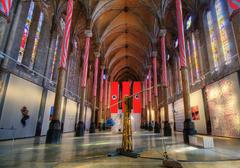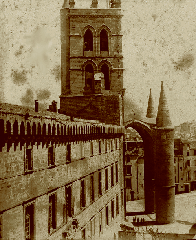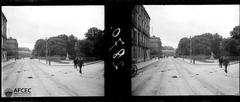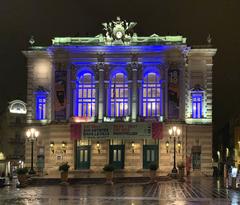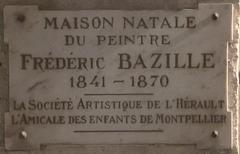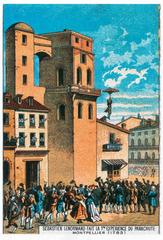Mas De Bagnères Visiting Hours, Tickets, and Travel Guide — Montpellier, France
Date: 03/07/2025
Introduction
Nestled in the vibrant city of Montpellier, France, Mas de Bagnères stands as a remarkable testament to 18th-century rural heritage and bourgeois architectural elegance. Originally constructed during a period of agricultural expansion and prosperity in the Languedoc region, this historic estate offers a unique window into Enlightenment-era country life that flourished alongside the city’s urban development. As a classic “mas,” it harmoniously blends agricultural function with refined living, reflecting the lifestyle of southern France’s rural nobility.
Today, Mas de Bagnères is recognized as a protected Monument Historique and continues to play a significant role in Montpellier’s cultural landscape. While its primary function is now residential, it remains a site of community engagement and heritage preservation, occasionally opening its doors to the public during special events. This guide covers its history, architectural features, legal protections, visiting details, and nearby attractions, helping you plan an enriching experience in Montpellier. For further details, consult official tourism and heritage resources (Wikipatrimoine; Montpellier Tourism; French Ministry of Culture).
Table of Contents
- Introduction
- Origins and Historical Development
- Architectural Features and Estate Layout
- Historical Significance in Montpellier’s Heritage
- Preservation Status and Legal Protection
- Conservation Efforts and Challenges
- Visiting Information: Hours, Tickets, and Accessibility
- Practical Tips and Nearby Attractions
- Role in Local Heritage and Community Engagement
- Frequently Asked Questions (FAQ)
- Summary and Final Tips
- References
Origins and Historical Development
The Mas de Bagnères is an exemplary 18th-century rural estate, located in the Hérault department. The term “mas” denotes a traditional farmhouse or rural property typical of Languedoc and Provence. Constructed amid a wave of rural expansion, the estate was established by Montpellier’s bourgeoisie, who sought to combine agricultural productivity with the comforts of a refined country retreat (Wikipatrimoine; Montpellier Tourism).
This period saw Montpellier thrive as a center for trade, viticulture, and intellectual life. Wealthy families invested in rural domains, creating estates that functioned as both productive farms and elegant escapes from urban life. The Mas de Bagnères, therefore, embodies both agricultural utility and the aesthetics of a “campagne bourgeoise”—a bourgeois country house.
Architectural Features and Estate Layout
Mas de Bagnères is notable for its architectural integrity and preservation. Its design showcases:
- Residential Quarters: The main house features symmetrical facades, classical proportions, and stone masonry, echoing Enlightenment-era architectural ideals (French Heritage).
- Agricultural Outbuildings: Barns, stables, and storage facilities organized for efficient farm management.
- Landscaped Grounds: Gardens, orchards, and possibly vineyards, reflecting the dual function of productivity and leisure.
The estate’s layout remains remarkably authentic, with much of its original structure and “second œuvre” (secondary works) intact—an uncommon feat among rural properties.
Historical Significance in Montpellier’s Heritage
Mas de Bagnères holds a pivotal place in the region’s rural and architectural history. It represents the transformation of Montpellier’s countryside estates from utilitarian farms to sophisticated domains reflecting their owners’ social aspirations. The estate is a physical testament to 18th-century prosperity and the merging of urban and rural lifestyles.
It also reflects the Languedoc’s broader Enlightenment transformation, characterized by agricultural innovation and the adoption of classical architectural motifs. As such, Mas de Bagnères is a valuable study in the intersection of rural life, social status, and architectural progress in pre-Revolutionary France.
Preservation Status and Legal Protection
Mas de Bagnères is officially listed as a Monument Historique (since July 5, 2006), with key elements such as the maison de maître, wine vats, park, and noria (water wheel) under protection (POP Culture Gouv; Monumentum). This status ensures any restoration or alterations meet strict heritage guidelines, preserving the estate’s character and enabling access to public funding and expert oversight.
Conservation Efforts and Challenges
Preserving an 18th-century estate like Mas de Bagnères involves:
- Structural Maintenance: Specialized restoration of masonry, roofing, and woodwork using traditional materials and techniques.
- Adaptive Reuse: Balancing modern needs (e.g., residential amenities) with the imperative to preserve historical features.
- Environmental Impact: Mediterranean climate conditions, such as hot summers and heavy rains, require constant maintenance.
Conservation follows principles of minimal intervention and reversibility, ensuring the estate’s historic fabric remains uncompromised.
Visiting Information: Hours, Tickets, and Accessibility
Current Use and Public Access
Since January 2025, Mas de Bagnères is managed as “Résidence Mas de Bagnères” by ACM HABITAT (ACM HABITAT). It functions primarily as a residential complex, so regular public access is not available.
Visiting Hours and Tickets
- General Access: Not open to the public on a regular basis.
- Special Opening: Usually accessible during the annual Journées Européennes du Patrimoine (European Heritage Days) in September. Hours and availability change yearly; check in advance.
- Tickets: Admission is generally free during Heritage Days. Guided tours may require advance registration.
Guided Tours and Events
- Tours: Offered during Heritage Days or special cultural events. Check ACM HABITAT or local heritage sites for updates.
- Photography: Permitted during public openings; respect residents’ privacy and posted guidelines.
Address and Getting There
- Address: 246 rue des Horaces, 34080 Montpellier, Occitanie (POP Culture Gouv).
- Public Transport: Served by Montpellier’s TAM network (buses/trams); nearby stops within walking distance (France Travel Blog).
- Cycling: Vélomagg’ bike stations are conveniently located nearby.
- Parking: On-site parking reserved for residents; use public lots in the area (Gralon).
Accessibility
Due to its historic architecture and residential use, accessibility features (ramps, lifts) may be limited. Visitors with reduced mobility should contact ACM HABITAT or Agence Lemasson in advance for current details (ACM HABITAT).
Practical Tips and Nearby Attractions
- Combine Visits: Plan to see Place de la Comédie, Tour de la Babotte, Église Saint-Michel de Montels, GGL Stadium, and Musée Fabre (Dreaming in French Blog).
- Transport: Use public transport or cycling; limited on-site parking for visitors.
- Best Time: European Heritage Days (September) for public access.
- Amenities: No tourist amenities on-site; cafés and shops nearby.
Role in Local Heritage and Community Engagement
Mas de Bagnères is more than a historical relic; it’s a living part of Montpellier’s community and heritage. Its protected status makes it a focal point for heritage education and cultural events. Collaboration with local authorities and organizations ensures its ongoing preservation and integration into community life.
Frequently Asked Questions (FAQ)
Q: What are Mas de Bagnères visiting hours?
A: Generally closed except for European Heritage Days (September). Confirm dates and hours in advance.
Q: Is there an entrance fee?
A: Admission is usually free during Heritage Days; guided tours may require advance booking.
Q: Are guided tours available?
A: Only during special events like Heritage Days.
Q: Is the site accessible for visitors with reduced mobility?
A: Accessibility is limited; contact ACM HABITAT or Agence Lemasson for details.
Q: What other historical sites can I visit nearby?
A: Place de la Comédie, Tour de la Babotte, Église Saint-Michel de Montels, and Musée Fabre.
Summary and Final Tips
Mas de Bagnères offers a rare glimpse into Montpellier’s rural past, blending 18th-century architecture and agricultural heritage within a modern residential context. Its Monument Historique status ensures the estate’s preservation and occasional public access, most notably during European Heritage Days. While spontaneous visits are not permitted, planning your trip around these annual events allows you to experience the estate’s historic ambiance. Take advantage of nearby Montpellier attractions and use official tourism and heritage resources to maximize your visit (POP Culture Gouv; ACM HABITAT; Montpellier Tourism).
Enhance your trip by downloading the Audiala app for personalized itineraries and stay connected with updates from local heritage organizations.
References
- Mas de Bagnères: A Historic 18th-Century Rural Estate and Visiting Guide in Montpellier, 2025, Wikipatrimoine
- Montpellier Tourism, 2025
- French Ministry of Culture, 2025
- Visiting Mas De Bagnères in Montpellier: Hours, Tickets, and Historical Insights, 2025, POP Culture Gouv
- ACM HABITAT Residence Mas de Bagnères, 2025
For visuals, maps, and virtual tours, consult the official Montpellier tourism resources and heritage sites.
